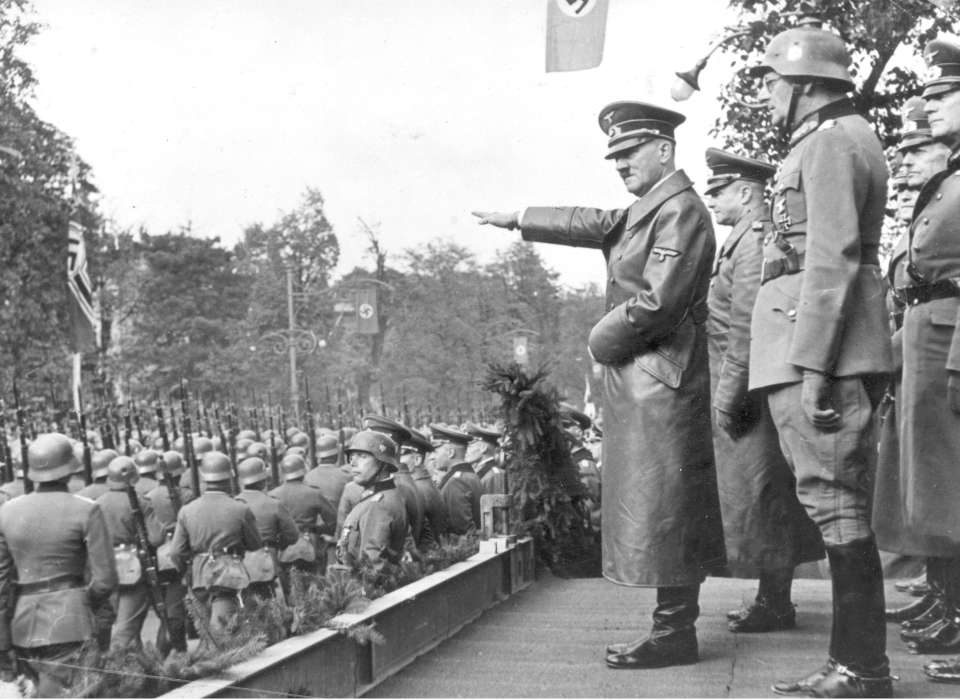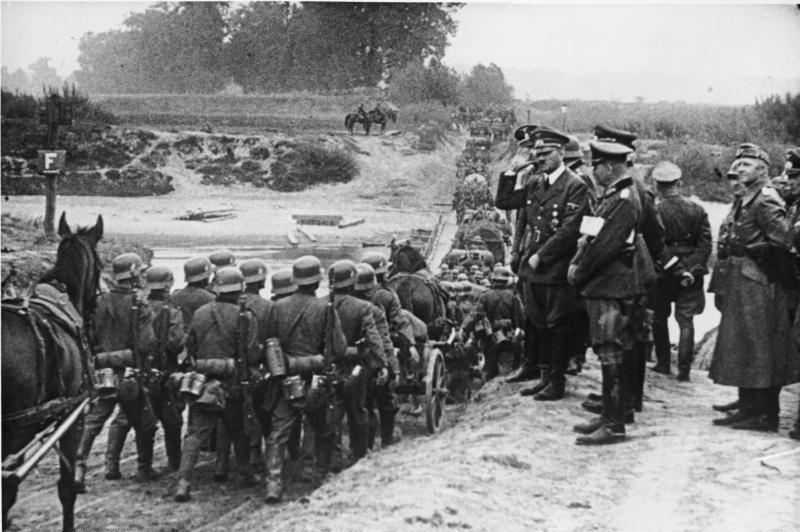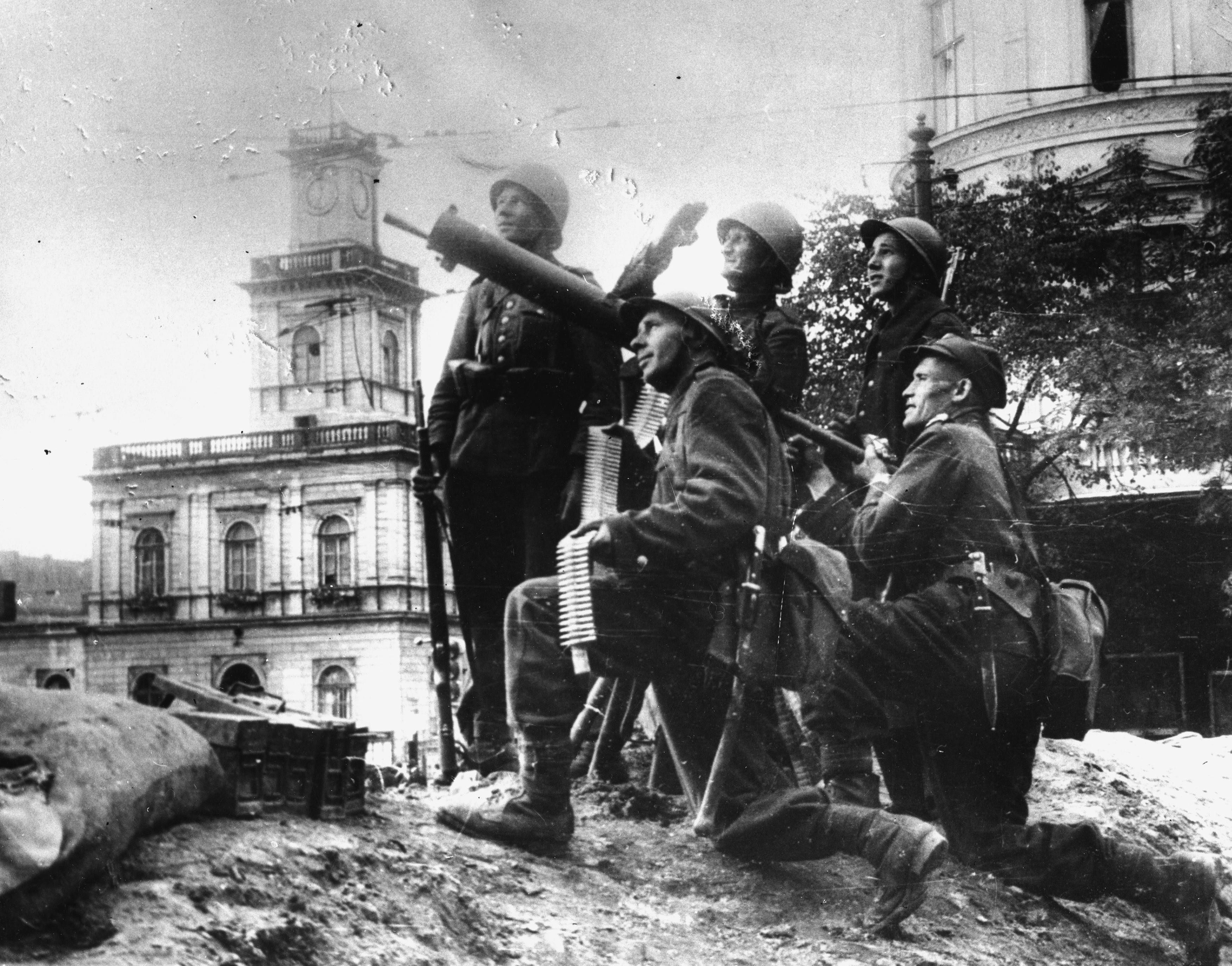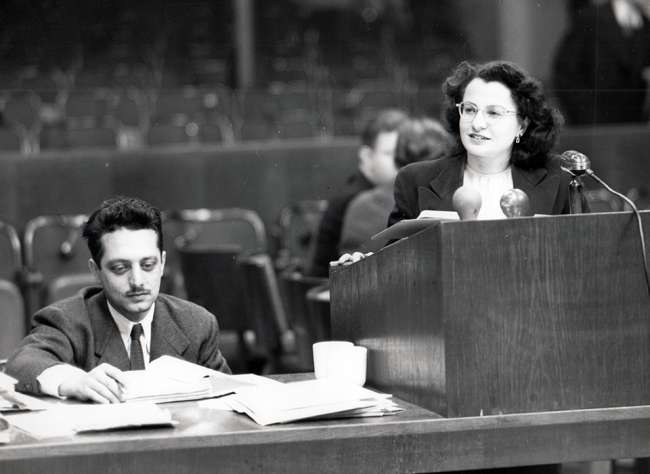Top Photo: Adolf Hitler receives a parade of German troops at Aleje Ujazdowskie in Warsaw, October 5, 1939. (Wikimedia Commons)
On August 25, 1939, the aging German pre-dreadnought battleship Schleswig-Holstein arrived in the port of the Free City of Danzig. Officially, it was there to celebrate the anniversary of the German victory in the Battle of Tannenberg in World War I: colorful flags flew from the masts and the men stood at attention in their white dress uniforms, brass buttons shining in the late summer sun. But the ship had a more sinister purpose. Unbeknownst to onlookers, over 200 marines were hidden below deck, preparing for a deliberate and unprovoked attack against Poland. In the gray morning light of September 1, 1939, the ship quietly moved the short distance from Danzig harbor to the Bend of Five Whistles, across from the small Polish military transit depot at Westerplatte.
It opened fire at 4:43 a.m., marking the beginning of World War II.
Long before Adolf Hitler took power in January 1933, he articulated his violent, racially based worldview in his book Mein Kampf. Germany should have won World War I, he argued, but it had been stabbed in the back by Jews and communists and reduced still further by the hated Treaty of Versailles. Only with Lebensraum, or “living space,” could Germans fulfill their destiny as the “master race.” For him, Germany’s future lay in territorial expansion. By the summer of 1939, Hitler had succeeded in annexing Austria, the Sudetenland, and, finally, all of Czechoslovakia without a shot being fired. Poland was to be next.
On April 28, Hitler withdrew from the nonaggression pact with Poland and the London Naval Agreement. At the same time, he learned that French and British talks to secure a nonaggression pact with the Soviets had broken down. Despite his disdain for the Bolsheviks, Hitler leapt at the chance to sign a peace treaty with Stalin that would allow him to wage war against Poland without risking either a two-front war with the West or having to contend with Soviet interference in the east. The result was the Molotov-Ribbentrop Pact of August 23, hastily signed so that Hitler could have his pact before his planned invasion of Poland. In the official agreement the Soviets promised not to aid Britain or France in the event of a war with Poland.[1] However, the crucial part of the agreement was a secret protocol that reshaped the map of central Europe. According to this, Bessarabia, Finland, Estonia, Latvia, and eastern Poland would become part of Stalin’s sphere of influence while Hitler would get all of western Poland. As Timothy Snyder put it, “the two regimes immediately found common ground in their mutual aspiration to destroy Poland.…Hitler saw Poland as the ‘unreal creation’ of the Treaty of Versailles, Molotov as its ‘ugly offspring.’”[2]
'Case White' The Nazi Invasion of Poland
With his eastern flank secure, Hitler ordered his generals to finalize “Case White,” the invasion of Poland. He said that this was a matter of “expanding our living space in the east and making our food supply secure; to have sufficient food you must have sparsely settled areas. There is therefore no question of sparing Poland, and the decision is to attack Poland at the first opportunity. We cannot expect a repetition of Czechoslovakia. There will be fighting.”[3]
From the beginning, this was to be a different kind of war—a war not only of conquest but also of annihilation. On August 22, just before the invasion, Hitler delivered a speech to his military commanders at Obersalzberg. In the speech, he said that the object of the war was to physically destroy the enemy. Men, women, and children of Polish descent or language were to be killed without pity. The campaign was to be carried out “with the greatest brutality and without mercy.”[4] To that end, the Einsatzgruppen—SS death squads—and police battalions were formed to exterminate Poles who might oppose German rule. Lists were drawn up of prominent men and women who were to be tracked down and killed as soon as possible. Cities like Warsaw were eventually to be “cleansed” of their Jewish populations and the ethnic Polish population reduced to a small group of slave laborers. Hitler devised a monstrous plan of colonization based on extreme violence and murder; tragically, those plans would evolve into unimaginable crimes that would culminate in the creation of a new kind of industrial-scale killing: the extermination camp.
The military attack against Poland was masterminded by Hitler with the details worked out by General Franz Halder, the chief of the general staff, and Walter von Brauchitsch, commander in chief of the campaign. Hitler was determined to make it look as if the Poles had provoked the hostilities and the SS obliged by staging numerous false-flag operations and “Polish provocations” against Germans. According to the testimony of Sturmbannführer Alfred Naujocks at Nuremberg, Reinhard Heydrich and Heinrich “Gestapo” Müller ordered Operation Himmler to make the Poles appear to be the aggressors and to justify the coming war. The most infamous of these was the staged attack at a radio station in Gleiwitz on the German-Polish border on the night of August 31, 1939. Local Silesian German farmer Franciszek Honiok, who was known to be sympathetic to Poland, was arrested by the Gestapo, drugged, and shot. The Germans pretended that Poles had stormed the station and taken over; Honiok’s body was left as “evidence.” It was a lie from beginning to end, but Joseph Goebbels’s propaganda machine was soon churning out stories about the heinous attack. By the morning of September 1, 1939, Hitler was already using the Gleiwitz incident to justify his invasion of Poland. The attack at Westerplatte followed shortly after, sealing Poland’s fate.
By dawn on September 1, German forces were crossing the border from three different directions. The main attack by Army Group South took place from the west over Silesia under Colonel General Gerd von Rundstedt. General Johannes Blaskowitz’s 8th Army went toward Lodz, General Wilhelm List’s 14th Army to Krakow, while General Walter von Reichenau spearheaded the attack toward Warsaw. The second route was from Prussia under Colonel General Fedor von Bock and Army Group North. General Georg von Küchler’s 3rd Army pushed in from East Prussia while General Günther von Kluge’s 4th Army attacked the Polish Corridor. There was a smaller attack by Slovakian units in the south, and the Germans hoped that a fifth column of Volksdeutsche, or ethnic Germans living in Polish territory who were sympathetic to the Third Reich, would aid the Nazi forces wherever possible.
The fight was unequal from the beginning. The Germans had amassed an army of 1.5 million men for the attack along with 2,750 tanks, 2,315 aircraft, and 9,000 guns. Theoretically, the Poles had an army of one million men, but many were unable to mobilize; those who did had outdated equipment and far less of it with just 4,300 guns, 210 tanks, 670 tankettes, and 800 aircraft. The Polish plan was to put the bulk of their forces in the west to defend against German attacks and wait for the French and British, with whom the Poles had signed a March 31 military alliance, to attack Germany from the west. The Poles did not believe that their allies would allow them to be overrun by the Germans without coming to their aid. They were wrong.
To make matters worse, thanks to General Heinz Guderian, the Germans had a new way of waging war that would prove lethal to the Poles—Bewegungskrieg, or war of movement, which would come to be known as Blitzkrieg. The idea was that tank divisions, supported by the Luftwaffe, would race forward and punch holes in the enemy lines, shocking the opposition with their speed and strength. Nonmechanized forces would then move up allowing the tanks to leap forward again. The Germans also relied on other innovations such as the use of the methamphetamine Pervitin, which allowed soldiers to be able to fight for days without rest.
The Polish Defense
The Poles were not prepared for this new kind of warfare and by September 3, von Rundstedt’s divisions had reached far into southern Poland, von Kluge was at the Vistula River, and von Reichenau was heading toward Kielce. However, the Poles resisted fiercely and there were some notable Polish successes such as at Pułtusk, where they captured a large number of German tanks. Despite German propaganda to the contrary, Polish cavalry did not attack tanks with sabers on horseback; instead, cavalry brigades carried bolt-action rifles, machine guns, and antitank rifles, giving them access to concentrated firepower. At the Battle of Mokra, the Wołyńska Cavalry Brigade destroyed over 50 German tanks and inflicted 800 casualties in one of the only Polish victories of the war. The largest battle of the September Campaign, the Battle of Bzura, saw the Poles attack a flank of the German forces moving toward the city throwing the Germans back 20 kilometers. Even so, by September 19 the Poles had been encircled and 20,000 Polish soldiers had been killed. Churchill called the brave battle “an ever glorious struggle.” The surviving troops made their way to Warsaw to continue the fight.
Another German innovation of the September Campaign was mass terror bombing. One hundred and fifty towns and villages were targeted in first days; the little town of Wieluń was flattened on the first of September. Warsaw was repeatedly hit, marking the first time a major European city was bombed systematically by an enemy air force. The Poles continued to hold out. During the aerial defense of Warsaw between September 1–6, the Poles downed over 80 German bombers. In retaliation on September 10, the Germans carried out 17 consecutive bombing raids. At the same time, enemy tanks were closing in. About 150,000 civilians, terrified of the approaching army, feverishly dug antitank ditches and created barricades.
On September 8, German tanks encircled the Polish capital, and the attack began in the south. The Poles pushed the Panzers back. The Germans returned on the 9th, but the Poles threw Molotov cocktails and set fuel on fire on the roads, destroying dozens of tanks causing the Germans to retreat again. Approximately 140,000 poorly armed Polish soldiers defended Warsaw against 175,000 Germans armed with 1,000 artillery pieces and 1,000 aircraft. Even so, on September 15, the Warsaw garrison repelled three major attacks. A frustrated Hitler declared on September 25 that he wanted the immediate surrender of Warsaw. Some 560 tons of bombs were dropped that day, along with 72 tons of firebombs. Polish composer and Holocaust survivor Władysław Szpilman remembered the horror of the raids: “The noise of explosions merged with the constant thunder of guns, penetrated by the boom of nose-diving aircraft like electric drills boring holes in iron.”[5]
Added to that was the deliberate strafing of civilians. One of the most extraordinary records of the invasion of Poland was taken by the American filmmaker Julien Bryan, who entered Warsaw on September 7. His film, Siege, is a devastating account of his time in the city. At one point, he captures the moment when a Luftwaffe plane fires its machine guns and kills women working in a field. Bryan recorded the words of a young girl hugging one of the dead women: “Oh, my beautiful sister! What have they done to you? … Please talk to me! Please, oh, please! What will become of me without you!” Bryan later recalled: “I threw my arm about her and held her tightly, trying to comfort her. She cried. So did I and the two Polish officers who were with me. What could we, or anyone else, say to this child?” [6]
Soviet Invasion of Poland
Despite their valiant fight against such terrible odds, any chance of the Poles holding out was dashed on September 17 when Stalin invaded the part of Poland granted him under the Molotov-Ribbentrop Pact. The Soviets attacked with over 450,000 troops, 4,736 tanks, and 3,300 aircraft. The Polish army was already mortally weakened, and plans to mount a defense in the south at the Romanian bridgehead were now obsolete. Warsaw surrendered on September 27 with a final death toll of over 20,000 civilians. Fighting continued as Germans and Soviets quashed final pockets of resistance, but on October 6, following the Polish defeat at the Battle of Kock, German and Soviet forces gained full control over the battered country. Although Poland never formally surrendered, this marked the end of the Second Polish Republic. The Polish dream of independence, which had appeared so full of promise in 1918, had come to an end.
What followed was death and destruction on a colossal scale by two of the most horrific dictatorships the world has ever seen. In the west, Hitler’s racial war saw marauding SS, Einsatzgruppen, and Wehrmacht soldiers mete out violence toward the Polish elite and increasingly Poland’s Jews in an escalating whirlwind of violence. In the east, over one million Poles were rounded up and deported to the Soviet Union, including 20,000 officers who would be murdered by Stalin at Katyn. Over 100,000 Polish soldiers escaped and would go on to fight in virtually every front in Europe, from the Battle of Britain to Narvik to Driel. Many of those deported to the Soviet Union would later form the Anders Army, trekking via Iran and Palestine to fight under the British at places like Monte Cassino. Those who stayed in Poland would create the largest underground army in occupied Europe, and one of their greatest contributions would be in intelligence, helping the Allies in cracking Enigma, obtaining the V-2 rocket, and alerting the West to the horrors of the Holocaust. Tragically, for the Poles, the freedom they had fought so valiantly for eluded them in 1945 when they were forced to exchange one dictatorship for another, but they continued to fight for freedom which they finally won in 1989.
The story of the September Campaign of 1939 is worthy of being remembered both as part of the long Polish fight for freedom, and as the opening act of World War II.
References:
[1]Ian Ona Johnson, Faustian Bargain: The Soviet-German Partnership and the Origins of the Second World War, (Oxford: Oxford University Press, 2021), 21.
[2] Timothy Snyder, Bloodlands: Europe Between Hitler and Stalin (New York: Basic Books, 2010),116.
[3] Notes from Admiral Wilhelm Canaris’s diary quoted in Winifried Baumgart “Zur Ansprache Hitlers vor den Fu”hrern der Wehrmacht am 22 August 1939”, Vierteljahrshefte für Zeitgeschichte, 19 no. 2 (July 9, 1971): 303.
[4] Document PS-1014 “Fuhrer’s Speech (second) to the Commanders-in-Chief”, August 22, 1939, Trials of War Criminals before the Nuremberg Military Tribunals, vol. 10, (Washington, D.C.: US Government Printing Press, 1949), 702.
[5]Wladysław Szpilman, The Pianist - The Extraordinary Story of One Man’s Survival in Warsaw, 1939-45 (2002), 40.
[6] Roger Moorhouse, The First to Fight - The Polish War 1939 (New York: Vintage, 2020) 158.
Alexandra Richie, PHD
Alexandra Richie, DPhil, is a historian of Germany and Central and Eastern Europe, with a specialization in defense and security issues.
Cite this article:
MLA Citation:
APA Citation:
Chicago Style Citation:











